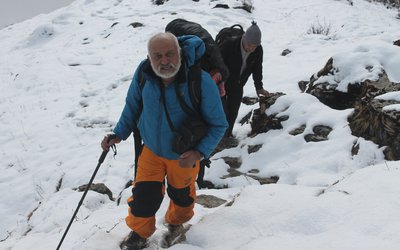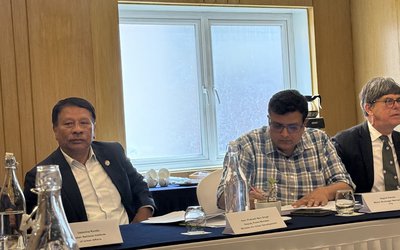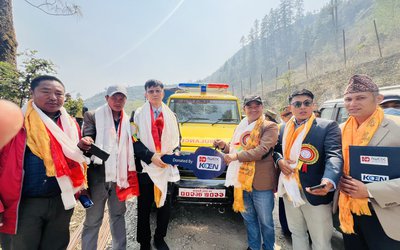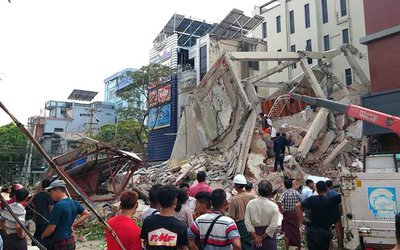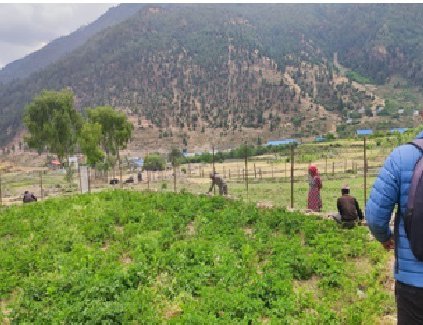
Information update on adaptation interventions in Nepal through google search showed research papers, reports and blogs on the outcomes of a structured National Framework on Local Adaptation Plan for Action (LAPA), 2011. LAPAs were first prepared and implemented in target districts and municipalities under UK Aid-supported Nepal Climate Change Support Programme (NCCSP).
Reviewed papers provide researchers' agenda-based 'academic opinions' and recommendations to localise climate change adaptation (CCA) through LAPAs.Researchers pointed out deficiencies in LAPAs which are also related to climate justice and equity, low level of implementation, non-targeted LAPAs, technocratic control, little inclusive LAPAs or non-consideration of LGBTQ+ communities etc. Someissues do not correspond to the baseline information.
As Nepal pioneered in localising CCA measures through LAPAs and being engaged in its preparation to the approval process, this note might be useful to enhance understanding of those engaged in LAPA preparation, implementation and monitoring, and in reviewand sharing research outcomes.
The call of the UN Framework Convention on Climate Change to prepare for adaptation, support in meeting the costs of adaptation to address climate change impacts, and largely to operationalise the Article 4.9 of the Convention (related to funding and technology support to the LDCs), Parties made a package of decisions in 2001 to support for the preparation of the National Adaptation Programme of Action (NAPA) to address most urgent and immediate adaptation needs, adopted the NAPA preparation guidelines, including the LDC work programme, established the LDC Fund and the LDC Expert Group (LEG) to support LDCs in adaptation matters. LDCs started preparing and implementing NAPAs initially by accessing the LDC Fund through the GEF Implementing Agencies. Inclusion of adaptation reporting through national communication and the Nairobi work programme on impacts, vulnerability and adaptation in 2005 further enhanced understanding on CCA needs.
The Kyoto Protocol provisions to formulate and implement adaptation measures and to mobilise the share of proceeds ofcertified projects (for carbon trade) to meet the costs of adaptation. To operationalise it, Adaptation Fund has been established under this Protocol.
In 2010 at Cancun, number of decisions on CCA were made. Parties adopted the Cancun Adaptation Framework, established Adaptation Committee and a process to formulate and implement the national adaptation plan (NAP), and extended LEG's mandate to support LDCs in identifying and prioritising medium- and long-term adaptation needs.
The Paris Agreement in its Article 7 provisions for, inter alia, global goal on adaptation(GGA) to enhance adaptive capacity, strengthen resilience, reduce climate vulnerability, and ensure adequate adaptation responses, including provisions for funding and technology support. It focuses to implementing country-driven, gender responsive, participatory and fully transparent adaptation actions. The Global Stocktake recognises adaptation efforts, enhances implementation of adaptation actions, review the adequacy and effectiveness of adaptation and support provided, and review overall progress made in achieving the GGA. To operationalise these provisions, each CoP has made substantial decisions on adaptation and support mechanisms.
Recent decisions through Glasgow Climate Pact and Glasgow-Sharm el-Sheikh Programme on GGA and UAE Framework for Global Climate Resilience and UAE-Bẻlen work programme on the development of indicators provides hope in further streamlining adaptation interventions. This clearly indicate global initiatives and guidance on CCA. The global undertakings through legally binding instruments provide multiple opportunities to scale-up adaptation interventions. The following paras focus on Nepal's decade-long initiatives in localising adaptation activities.
Nepal realised the adaptation needs through an analysis of climate vulnerability in agriculture, water resources, natural forests and health sectors along with adaptation measures in practice as included in the initial national communication (2004). Nepal's participation in LEG explored possibilities to prepare and implement NAPAs and access funding for adaptation programmes. Nepal represented Asian LDCs in LEG for 2004-'05 and continuously from 2008to 2023. Shechaired the LDC Coordination Group (UNFCCC) for 2014-2015 and represented the LDC group in the Adaptation Fund Board (for 2015-'16, and 2023-'24).
Idea of localising adaptation actions emerged at NAPA inception workshop on 25-26 May 2009. With support from the UK Aidto the Climate Adaptation Design and Piloting (CADP) Project and technical support of 9 NGOs, a LAPA Framework was drafted, and piloted in 10 districts namely, Ilam,Udayapur,Nawalparasi, Kaski, Kapilvastu, Pyuthan, Rukum, Kalikot, Achham and Dadeldhura. Six consultations were organised (4 in development regions and 2 in Kathmandu) to enhance understanding on the elements of the LAPA Framework, particularly of the then Local Development Officers (LDOs) and Planning Officers and collect concerns and difficulties in implementing it. Based on inputs received, the draft framework was revised, and official comments and suggestions were collected. The draft final framework was presented and discussed at the 6th meeting of the Multi-Stakeholder Climate Change Initiative Coordination Committee (MCCICC) held on 4 November 2011, and 8th meeting of the Climate Change Council, chaired by the Rt. Hon. Prime Minister on 14 November 2011. The Council decided for early processing for government approval and implementation. The Council of Ministers approved the National Framework on LAPA on 22 November 2011. Nepal shared its national system on localising adaptation initiatives with 47 LDCs on 23 November 2011 at Durban, South Africa during the pre-CoP17 meeting of the LDCs. This sharing continued till the adoption of the Paris Agreement in 2015.
The 2011 LAPA Framework contains 7 steps namely: (i) climate change sensitisation; (ii) climate vulnerability and adaptation assessment; (iii) prioritisation of adaptation options; (iv)LAPA formulation; (v) LAPA integration into planning process; (vi) LAPA implementation; and (vii) LAPA progress assessment with core and additional tools for its preparation. The LAPA Framework is a joint effort of relevant ministries - environment and local development. This 'branded' initiative prompted a funded-adaptation project in Pakistan to prepare and implement LAPAs.
The LAPA framework provided a basis to localise, internalise, institutionalise and integrate into development planning the adaptation interventions to build adaptive capacity and resilience of the climate vulnerable communities in target areas. Preparation and implementation of 100 LAPAs in 14 climate vulnerable districts of mid-and far west development regions under NCCSP since 2013 offers several lessons. A36 Palika-level LAPAs were prepared and implemented during NCCSP II till 2023. Google search informed: (i) 9 LAPAs prepared by Birat Nepal Medical Trust in 2014 for Kailali, Asham and Bajura; (ii) 118 LAPAs prepared and implemented under ASHA Project in Dailekh, Kalikot, Jajarkot, Rolpa, Rukum (East and West) and Salyan; and (iii) 20 LAPAs prepared under Multi-stakeholder Forestry Project in Koshi Hill districts. The 16th Plan informs 263 LAPAs under implementation. Several NGOs were engaged in designing, partnering and preparing LAPAs, including water-focussed LAPA, with primary focus in the climate vulnerable western parts of the country.
The NCCSP has promoted LAPAs in climate vulnerable districts of Lumbini to Sudur Paschim Provinces. Provincial and local leaders were exposed to address climate change impacts through LAPAs, build adaptive capacity of the climate vulnerable communities, and make infrastructures climateresilient through NCCSP and other initiatives. Expressions of mayors and deputy mayors and chairs and vice-chairs attending the NCCSP2: Learning Reflection Workshop with Local Government, held at Surkhet in June 2024 clearly informs LAPAs' contribution in improving livelihoods and advancing climate-friendly development in project target areas. Many people understand CCA synonymous to LAPAs.
Nepal's 'brand' LAPA offers options to further localise adaptation options utilising science and local knowledge and enhancing income-generating opportunities. LAPA process ensures identification and prioritisation of adaptation options. Review of 100 LAPAs under NCCSP I informs over 40 percent of the prioritised adaptation options related to agriculture, food security and livelihoods(photo: Bean production in Jumla) followed by climate-induced hazards and disasters, water resources,and infrastructure development. Over one-fourth of the prioritised activities in LAPAs were linked to capacity building. Hence, LAPA focusesonlivelihoods improvement, climate-induced disasters, and climate-resilient infrastructure.
Along with the change in political system through a constitution in 2015, the government has continued to localise adaptation measures. It has issued a LAPA Framework in 2019 which informs the preparation of over 700 LAPAs (for then municipalities and VDCs) and 2500 CAPAs (Community Adaptation Plan of Action) and few ecosystem-based adaptation plans. The word 'national' used in 2011 LAPA Framework was deleted in 2019. This 2019 Framework specifies the roles of three tiers of the government on CCA and climate-resilient development. The process includes 6 steps: (i) raise awareness and build capacity; (ii) analyse vulnerability and risks; (iii) identify adaptation and disaster risk reduction and management (DRR&M) strategies; (iv) mainstream strategies into local periodic plan and development policies; (v) also mainstream adaptation and DRR&M in annual plan, budget formulation, monitoring and evaluation processes; and (vi) formulate and implement adaptation and DRR&M activities at household, local communities and user group levels.State of LAPAs preparation and implementation using 2019 LAPA Framework is unclear.
The 2019 LAPA Framework, National Climate Change Policy(2019) and Environment Protection Act (2019) and its Rules (2020) clarify the roles and responsibilities of three-tiers of the government but complicates the process and creates confusions on environmental assessment system and carbon trade. Limiting environment and climate change within forests prevails.
Nepal's 'brand' LAPA stands on two strong legs - preparation and implementation of a stand-alone LAPA for any unit, and integration into local level annual, periodic and sector planning processes. It is the choice of the government and people to scale-up 'home-grown'LAPAs or test 'imported' models in the Nepalese soil or develop and implement'hybrid model'.
The Nationally Determined Contribution (NDC, 2020) has targeted to prepare and implement climate-resilient and gender-responsive adaptation plans in all 753 local government. Initial effort to prepare gender-responsive LAPAs for 5 Palikas may provide some guidance to the adaptation community and scale-up decade long adaptation journey in Nepal through LAPAs. This provides hope to enhance adaptive capacity,reduce vulnerability, build climate resilience, and adopt climate-friendly development pathway.

Batu Uprety
Former Joint-Secretary and Chief of Climate Change Management Division, Ministry of Environment (then), and former Team Leader, National Adaptation Plan (NAP) formulation process. E-mail: upretybk@gmail.com
- Sagarmatha Sambad: Likely Bearing the Fruits
- Mar 27, 2025
- Decadal Experience In Preparing The NDC
- Mar 03, 2025
- Over Five Decades Of Concern On Air Pollution
- Jan 16, 2025
- Damaging The Functional EIA Track
- Dec 22, 2024
- Baku CoP29 Outcomes And Nepal's Initiatives
- Nov 26, 2024

